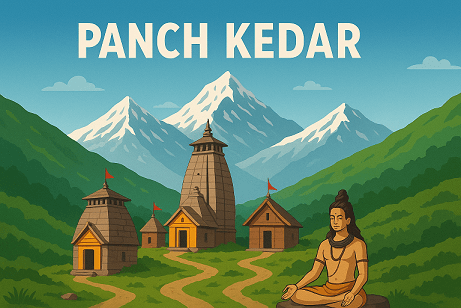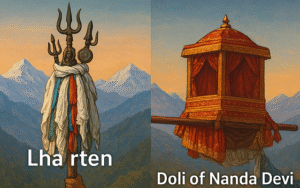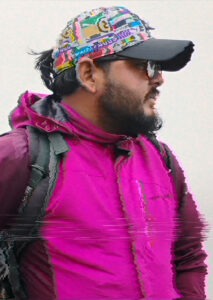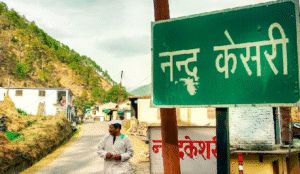Panch Kedar – A Deep Spiritual Journey into the Five Abodes of Lord Shiva

Mohit Bangari
Explore Himalaya With Me!!

Panch Kedar are the five holy temples of Lord Shiva in the Garhwal Himalayas of Uttarakhand. These temples are very sacred for Hindus. Every year thousands of devotees and trekkers visit them. The Panch Kedar yatra is not only a religious journey but also a path of self-purification and forgiveness.
I have already written separate articles on each of the Panch Kedars. You can read about them in detail here – Kedarnath, Madmaheshwar, Rudranath, Tungnath and Kalpeshwar.
Table of Contents
The Story Behind Panch Kedar
After the Mahabharata war, the Pandavas were filled with guilt for killing their own brothers and relatives. Lord Krishna advised them that only Lord Shiva could forgive their sins. But Shiva was angry and he did not want to meet them. So he went into the Himalayas and took the form of a bull (Nandi).
The Pandavas kept searching and finally found him in Guptkashi. Bhima tried to hold the bull, but suddenly it disappeared into the ground. Different parts of Shiva’s body appeared in five places of Garhwal. These places became known as Panch Kedar:
The hump appeared at Kedarnath
The arms appeared at Tungnath
The face appeared at Rudranath
The navel and stomach appeared at Madhyamaheshwar
The hair (jata) appeared at Kalpeshwar
The Pandavas then built temples at these five places and worshipped Shiva. It is also said that after completing the worship, they performed a special yagna at Kedarnath and got salvation.
Religious Importance of Panch Kedar
The Panch Kedar yatra is considered very holy. It is said that anyone who completes this yatra with pure heart and devotion gets freedom from sins. Devotees also believe that visiting these temples helps in spiritual growth, peace of mind, and divine blessings.
There is also a tradition that after visiting all the Panch Kedar, one must visit Badrinath temple to complete the yatra. In this way, both Shiva and Vishnu’s darshan is done together which makes the journey complete.
Panch Kedar
1. Kedarnath – The Hump of Lord Shiva
Kedarnath is the most important temple among all the Panch Kedar. It is also one of the 12 Jyotirlingas of Lord Shiva. Situated at an altitude of about 3,583 metres, this temple is located near the Mandakini river in the Rudraprayag district. According to the story, the hump of Shiva in bull form appeared here. The Pandavas are believed to have first worshipped him here to seek forgiveness for their sins.
The trek to Kedarnath starts from Gaurikund and is around 16 km long. The temple remains open only from April/May till October/November. In winter, the idol is shifted to Ukhimath.
I have already written a full article on Kedarnath here: Click here to read
2. Tungnath – The Arms of Shiva
Tungnath is famous as the highest Shiva temple in the world, standing tall at about 3,680 metres. Here the arms of Shiva appeared. The temple is located in Rudraprayag district and is believed to be more than 1,000 years old. It is also closely linked to the Pandavas, who built this temple after recognizing Shiva’s presence.
The trek to Tungnath is short but very scenic, just 3–4 km from Chopta. The path is surrounded by bugyals (meadows) and high Himalayan peaks. Chandrashila peak is just 1.5 km further up, from where the view of Nanda Devi, Chaukhamba, and Trishul peaks looks heavenly.
I have written a complete article on Tungnath as well: Click here to read
3. Rudranath – The Face of Shiva
Rudranath is the only temple where the face (mukha) of Lord Shiva is worshipped. Located at an altitude of around 3,550 metres, this temple is deep inside alpine meadows, forests, and mountain ridges. According to the story, when Shiva disappeared into the ground as a bull, his face appeared here.
The trek to Rudranath is considered one of the toughest among Panch Kedar. From Sagar village, the trek is about 20 km through dense forests, rivers, and high-altitude meadows. The temple is surrounded by many kunds (sacred ponds) like Surya Kund, Chandra Kund, and Manas Kund, which increase its spiritual importance.
You can read my detailed guide on Rudranath here: Click here to read
4. Madhyamaheshwar – The Navel and Stomach of Shiva
Madhyamaheshwar, also known as Madmaheshwar, is located at an altitude of about 3,497 metres in the Rudraprayag district. Here the navel and stomach of Shiva appeared. The temple is built in the traditional north Indian style with stone architecture. The peaceful surroundings and lush green meadows make this place divine.
The trek to Madhyamaheshwar starts from Ransi village and is around 18 km. The path passes through villages, dense forests, and bugyals. During winters, the idol of the temple is shifted to Ukhimath, where it is worshipped.
I have written a complete travel and trekking guide on Madhyamaheshwar: Click here to read
5. Kalpeshwar – The Hair (Jata) of Shiva
Kalpeshwar is the last temple of the Panch Kedar circuit and the only one which remains open throughout the year. Located in Urgam Valley at about 2,200 metres, this temple is surrounded by apple orchards, caves, and forests. Here the hair (jata) of Lord Shiva is worshipped.
The trek to Kalpeshwar is the shortest among Panch Kedar. One can reach Urgam village by road and then walk about 2 km to reach the temple. Kalpeshwar is also associated with the story of rishi Durvasa, who meditated here. Its year-round accessibility makes it very important for devotees.
I have also written a detailed article on Kalpeshwar: Click here to read
Winter Homes of Panch Kedar
Due to heavy snowfall, the high Himalayan temples of Panch Kedar remain closed during the winter months, usually from November to April. During this time, the idols are shifted to nearby villages and worship continues there with full rituals. This tradition makes sure that devotees can worship Lord Shiva even when the main shrines are shut.
Kedarnath & Madhyamaheshwar – In winter, their idols are shifted to Omkareshwar Temple, Ukhimath. This temple becomes the main worship place for both shrines.
Tungnath – The idol is moved to Makkumath village, which is near Chopta.
Rudranath – Its idol is shifted to Gopeshwar, the district headquarters of Chamoli.
Kalpeshwar – This is the only temple of Panch Kedar that remains open throughout the year, so no shifting is needed.
This winter worship tradition is very special. It keeps the connection between the people and Lord Shiva alive, even in the toughest Himalayan winters.
Panch Kedar Yatra Itinerary (16 Days Plan)
Day 1: Arrival in Rishikesh/Haridwar
Reach by train, bus, or flight (Dehradun airport).
Stay overnight in Rishikesh. Attend evening Ganga Aarti.
Day 2: Rishikesh to Guptkashi (220 km / 8–9 hrs)
Drive via Devprayag, Rudraprayag, and river valleys.
Stay at Guptkashi (base for Kedarnath).
Day 3: Guptkashi to Gaurikund – Trek to Kedarnath (16 km)
Drive 30 km to Gaurikund.
Trek 16 km (pony/palki/helicopter also available).
Stay near Kedarnath temple.
Day 4: Kedarnath Darshan – Return to Guptkashi
Early morning darshan at Kedarnath (hump of Shiva).
Trek back to Gaurikund and drive to Guptkashi.
Day 5: Guptkashi to Ransi – Trek to Gaundar (6 km)
Drive 65 km to Ransi village.
Start trek to Gaundar village (6 km).
Stay at Gaundar (basic homestays).
Day 6: Gaundar to Madhyamaheshwar (12 km)
Trek 12 km through forests and meadows.
Reach Madhyamaheshwar temple (navel and stomach of Shiva).
Stay overnight at temple vicinity.
Day 7: Madhyamaheshwar Darshan – Return to Ransi
Early darshan at the temple.
Trek back 18 km to Ransi.
Stay overnight.
Day 8: Ransi to Chopta (75 km / 3–4 hrs)
Drive to Chopta, base for Tungnath.
Rest and stay overnight.
Day 9: Tungnath & Chandrashila Trek (5 km up / 5 km down)
Trek 3.5 km to Tungnath temple (arms of Shiva).
Optional: continue 1.5 km up to Chandrashila peak.
Return to Chopta by evening.
Day 10: Chopta to Sagar Village – Trek to Panar Bugyal (12 km)
Drive 40 km to Sagar village.
Trek 12 km to Panar Bugyal.
Camp overnight in meadows.
Day 11: Panar Bugyal to Rudranath (8 km)
Trek to Rudranath temple (face of Shiva).
Explore surrounding kunds – Surya Kund, Chandra Kund, Manas Kund.
Stay overnight at Rudranath (basic lodges/dharamshala).
Day 12: Rudranath to Sagar Village – Drive to Joshimath
Trek back to Sagar (20 km).
Drive 70 km to Joshimath. Stay overnight.
Day 13: Joshimath to Helang – Trek to Urgam (2 km)
Drive to Helang (12 km).
From there, small drive to Urgam village.
Trek 2 km to Kalpeshwar temple (jata of Shiva).
Stay in Urgam.
Day 14: Kalpeshwar Darshan – Return to Joshimath
Morning puja at Kalpeshwar.
Trek back to Urgam roadhead and drive to Joshimath/Pipalkoti.
Day 15: Joshimath to Rishikesh/Haridwar (270 km)
Drive back through Chamoli, Karnaprayag, Srinagar, Devprayag.
Stay overnight in Rishikesh/Haridwar.
Day 16: Departure
End of Panch Kedar Yatra.
Optional: Visit Badrinath temple before heading back, as many yatris complete Panch Kedar with Badrinath darshan.
Extra Tips
Best season: May–June & Sept–Oct.
Fitness needed: Rudranath and Madhyamaheshwar treks are long and tough.
Always carry woolens, raincoat, torch, and basic medicines.
Kalpeshwar is open all year, rest are only open May–Oct.
Trekking and Best Time to Visit
Kedarnath trek starts from Gaurikund and is around 16 km.
Tungnath trek is the easiest, only 3–4 km from Chopta.
Rudranath trek is long and tough, nearly 20 km through dense forest.
Madhyamaheshwar trek is around 18 km from Ransi village.
Kalpeshwar trek is short, about 2 km from Urgam.
The best time to visit is from May to October. In winter due to heavy snowfall, the temples (except Kalpeshwar) remain closed. During this time, the idols are shifted to nearby villages for worship.
FAQs on Panch Kedar
Q1. What is the best order to visit Panch Kedar temples?
The traditional order is – Kedarnath, Tungnath, Rudranath, Madhyamaheshwar, and Kalpeshwar. Many people also end their journey with Badrinath darshan to complete the yatra.
Q2. How many days are needed for the full Panch Kedar Yatra?
It usually takes around 15 to 20 days depending on trekking speed and route. Kedarnath and Kalpeshwar are easier, while Rudranath and Madhyamaheshwar need more trekking time.
Q3. Which is the easiest temple among Panch Kedar?
Kalpeshwar is the easiest. It is just a 2 km trek from Urgam village and remains open throughout the year.
Q4. Which is the toughest temple to reach?
Rudranath is the toughest. The trek is long, about 18–20 km through dense forest, high altitude meadows, and mountain ridges.
Q5. When is the best time to visit Panch Kedar?
The temples (except Kalpeshwar) remain open from May to October. This is the best time to visit as the weather is clear and the treks are accessible.
Q6. Can the Panch Kedar Yatra be done by all age groups?
Yes, but people should be fit. The treks are moderate to tough, especially Rudranath and Madhyamaheshwar. Senior citizens or children can do easier temples like Kalpeshwar and Tungnath.
Q7. Why are the Panch Kedar temples so important?
They are directly linked to the Pandavas and Mahabharata story. Each temple is a part of Lord Shiva’s divine form. Completing the Panch Kedar Yatra is believed to free one from sins and bring inner peace.
Conclusion
Panch Kedar is not just a yatra, it is a complete spiritual journey. The story of Pandavas, Lord Shiva’s divine presence, and the beauty of the Himalayas all come together in this pilgrimage. Each temple has its own importance, and together they tell the story of faith, forgiveness, and devotion.
For me, Panch Kedar is a symbol of the deep connection between humans and the divine. It is a journey where you walk on mountain paths but also travel inside your own heart. Truly, Panch Kedar is the soul of Shiva’s presence in the Himalayas.
– By Mohit Bangari
ॐ नमः शिवाय
“I bow to Lord Shiva, the supreme consciousness, the inner self.”
Summary Table
| Temple | Shiva Part | Elevation | Access & Season | Significance |
|---|---|---|---|---|
| Kedarnath | Hump | 3,583 m | Trek from Gaurikund (May–Oct) | Primary shrine & Jyotirlinga |
| Tungnath | Arms | 3,680 m | 3–4 km trek (May–Nov) | Highest Shiva temple |
| Rudranath | Face | ~3,550 m | Long trek (~20 km) | Peaceful & remote Shiva darshan |
| Madhyamaheshwar | Navel & Stomach | 3,497 m | ~18 km trek | Center of divine energy |
| Kalpeshwar | Hair (Jata) | 2,200 m | Short trek, year-round | Easiest, tranquil, forested temple |
Related Post


Mohit Bangari
Explore Himalaya With Me!!


Explore the beauty and cultures of the Himalayas, from Jammu and Kashmir to Arunachal Pradesh, Tibet and Nepal. My blog shares stories, pictures, and fun articles about this amazing region. Come along on a journey where each mountain has a tale and every valley hides a treasure. Join me as I discover the magic of the mountains together.
Welcome to my Himalayan Adventure!




